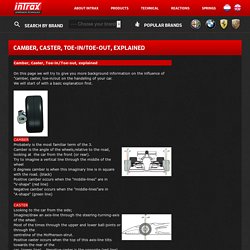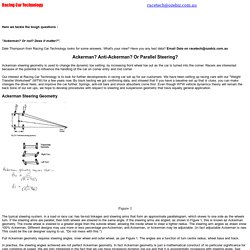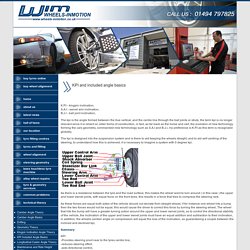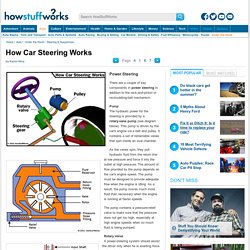

King Pin Inclination (KPI), Steering Axis Inclination (SAI) Развал - схождение (wheels-alignment) King Pin Inclination (KPI), Steering Axis Inclination (SAI), поперечный наклон оси поворота.

King Pin Inclination (KPI), Steering Axis Inclination (SAI) The angle formed by a line drawn through the upper and lower pivot points of the steering axis and a vertical line as viewed from the front (see fig. 152). Fig. 152 King Pin Inclination (KPI), Steering Axis Inclination (SAI) Camber, Caster, Toe-in/Toe-out, explained - Intrax Racing. TOE-IN / TOE-OUT Affects 3 majore areas; Tire wear, straight-line stability and corner entry handling.

For minimum tire-wear it would be ideal to have the wheels parralel / 0 degrees while riding. This can be acomplished to give a bit static toe-out to a frontwheel-drive car, or toe-in to a rearwheel-driver. A frontwheel-drive car has the tendency to understeer. Toe-out will induce a bit of oversteer, so it could compensate the frontwheel-driver's understeer. Home Page. Here we tackle the tough questions : "Ackerman?

Or not? Does it matter? ". Dale Thompson from Racing Car Technology looks for some answers. What's your view? Car Tyres Fitting and Wheel Alignment Specialists. K.P.I - kingpin inclination, S.A.I - swivel arm inclination, B.J.I - ball joint inclination, The kpi is the angle formed between the true vertical, and the centre line through the ball joints or struts, the term kpi is no longer relevant since it is reliant on older forms of construction, in fact, as far back as the horse and cart, the evolution of new technology forming the cars geometry, commanded new terminology such as S.A.I and B.J.I, my preference is K.P.I as this term is recognized globally, The kpi is designed into the suspension system and is there to aid keeping the wheels straight, and to aid self centring of the steering, to understand how this is achieved, it is necessary to imagine a system with 0 degree kpi.

As there is a resistance between the tyre and the road surface, this makes the wheel want to turn around ( in this case ) the upper and lower swivel joints, with equal force on the front tyres, this results in a force that tries to compress the steering rack. Summary. Caster, Camber, Toe. The following article is reprinted with the permission of Grassroots Motorsports magazine.

For more information from this fine publication, please point your browser to Grassroots Motorsports magazine. Pointed the Right Way story by john hagerman Camber, Caster and Toe: What Do They Mean? The three major alignment parameters on a car are toe, camber, and caster. When a pair of wheels is set so that their leading edges are pointed slightly towards each other, the wheel pair is said to have toe-in.
For minimum tire wear and power loss, the wheels on a given axle of a car should point directly ahead when the car is running in a straight line. So if minimum tire wear and power loss are achieved with zero toe, why have any toe angles at all? When the wheel on one side of the car encounters a disturbance, that wheel is pulled rearward about its steering axis. EPS system 1. Eps system. Power Steering - How Car Steering Works. There are a couple of key components in power steering in addition to the rack-and-pinion or recirculating-ball mechanism.

Pump The hydraulic power for the steering is provided by a rotary-vane pump (see diagram below). This pump is driven by the car's engine via a belt and pulley. It contains a set of retractable vanes that spin inside an oval chamber. As the vanes spin, they pull hydraulic fluid from the return line at low pressure and force it into the outlet at high pressure. The pump contains a pressure-relief valve to make sure that the pressure does not get too high, especially at high engine speeds when so much fluid is being pumped.
Rotary Valve. STEERING.